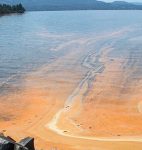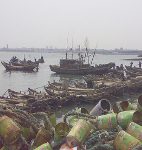Land reclamation in China has caused a steep decline in coastal plant life and seriously damaged local biodiversity. Here, we argue that natural ecosystems, such as coastal shoals, wetlands and mangrove forests, should be protected in order to boost vegetation levels on coastal and saline land and increase carbon dioxide absorption.
China’s coastal cities are experiencing a land reclamation boom, driven by the vast profits offered by new ground. One mu (around 667 square metres) of reclaimed land can be sold to a developer for one million yuan (US$149,000). With reclamation and construction costs of around 200,000 yuan (US$29,800) per square metre, that’s a 400% mark up.
But too much reclamation has been disastrous for coastal wetland ecologies. The extent of China’s mangrove forests has plummeted from 500 square kilometres 60 years ago to 150 square kilometres today as a result of reclamation and felling, and their fragile ecosystems are at the brink. Many organisms have lost their habitats and breeding grounds, and the coast its important function as a protective barrier. There is therefore an urgent need to regulate land reclamation, ensure responsible use of coastal areas, construct an environmental-compensation system for oceans and protect the ecosystems of coastal shoals, wetlands and mangrove forests.
Currently, 13% to 15% of construction activity in coastal provinces and cities – 3% to 4% of the country’s total – happens on reclaimed land. The State Council, China’s highest administrative authority, has approved plans for Liaoning Coastal Economic Zone, Hebei’s Caofeidian New Area, Tianjin Binhai New Area, Jiangsu Coastal Zone, Guangdong Pearl River delta area, Fujian Straits West Coast Economic Zone and Guangxi’s North Bay Economic Zone. Plans for the Shandong Peninsula Blue Economic Zone and Zhejiang Coastal Economic Zone are also being drawn up. Large swaths of these zones will be built on reclaimed land, presenting a huge challenge to the protection of coastal wetlands. Measures to increase ecological restoration must be fundamentally integrated into these developments.
Increased levels of vegetation on coastal shoals (sand or silt landforms that extend from the land into the sea) and saline soil would reduce the impact of ecological degradation and act as a carbon sink. Jiangsu alone has 6,873 square kilometres of shoals. These have already seen successful test plantings of over 10 salt-tolerant energy crops – low cost crops used to make biofuels – such as sweet sorghum, Jerusalem artichoke and salicaceae; 30 salt-tolerant vegetable crops, including dwarf saltwort and water celery; and salt-tolerant fodder crops including rye, alfalfa and salicornia europaea, otherwise known as pickleweed. Some fodder crops have a better ability to absorb carbon than forests. Ten thousand square metres of Astragalus sinicus, also called Chinese milkvetch, for example, can store 7.5 tonnes of carbon.
China has almost 347,000 square kilometres of saline soil and, in theory, planting half of this with crops such as salicaceae or alfalfa could lead to absorption of 100 million tonnes of carbon dioxide, and carbon-trading profits of 10 billion yuan. China’s reserved land includes almost 107,000 square kilometres of saline soil. If 40,000 square kilometres of this was planted with sweet sorghum or Jerusalem artichoke, 86 billion yuan of investment would be needed – but it would produce 20 million tonnes of biofuel, worth 100 billion yuan, not to mention 10 million jobs in agriculture and 130,000 more in processing.
Since 2002, the State Council and local governments have given the go-ahead for 740 square kilometres of land to be reclaimed. If we assume an environmental-compensation rate of 1.4 billion yuan per square kilometre, one trillion yuan of funds would have been raised under our proposed system. If for every mu (667 square metres) of land reclaimed, there was an obligation to restore 300 square metres of mangrove forest, plant 130,000 square metres of salt-tolerant energy forest and fodder or 40,000 square metres of salt-tolerant energy crops, the percentage of China’s energy drawn from non-fossil sources would greatly increase, much more carbon would be captured and many jobs created. As well as protecting the environment, such a system would also provide a new energy industry for local land-reclamation projects. We therefore propose:
First, the formation of an Oceanic Environmental Compensation Consultation Committee. At the end of 2009, the National Development and Reform Commission and the State Oceanic Administration announced that management of land reclamation would be strengthened and started a programme to revise the zoning of coastal areas. In tandem with this, the authorities and experts should form a committee to investigate and plan compensation and carbon-trading mechanisms, in line with the aims of the 12th Five-Year Plan.
Second, the establishment of a National Laboratory for Oceanic Environmental Compensation and Energy Crop Carbon Sequestration. China’s salty marshland covers an area equivalent to one third of its total arable land, and there are 420 types of salt-tolerant plants besides mangrove forests – energy crops such as sweet sorghum, Jerusalem artichoke and salicaceae. We propose a national laboratory to research the use of low-cost crops in shoals and salt marshes, coordinate practical aspects of the overall plan and strive towards environmental as well as economic success.
Third, establish a Coastal Shoals Carbon Trading Association and an Ecological Compensation Energy Farm Association. The first of these would, either under a cap-and-trade system or with financial and technical support for ocean projects, use a portion of income from land reclamation to subsidise the planting of economic crops on shoals. The second would explore possibilities for an oceanic environmental compensation system responsible for restoring mangrove forests, shoals and wetlands and establishing farms for energy crops. Ultimately, these would bring the carbon-trading strengths of coastal energy crops into play, reducing greenhouse-gas emissions and benefitting the coastal economy.
Jiang Gaoming is chief researcher at the Chinese Academy of Sciences’ Institute of Botany and vice secretary-general of the Ecological Society of China
Dou Guanyi is a member of the Environment and Resources Committee of the September 3rd Society.
Chen Bosen is deputy head of the Nantong City Committee of the September 3rd Society.
Homepage image of construction in the Pearl River delta from Huizhou.gov.cn


